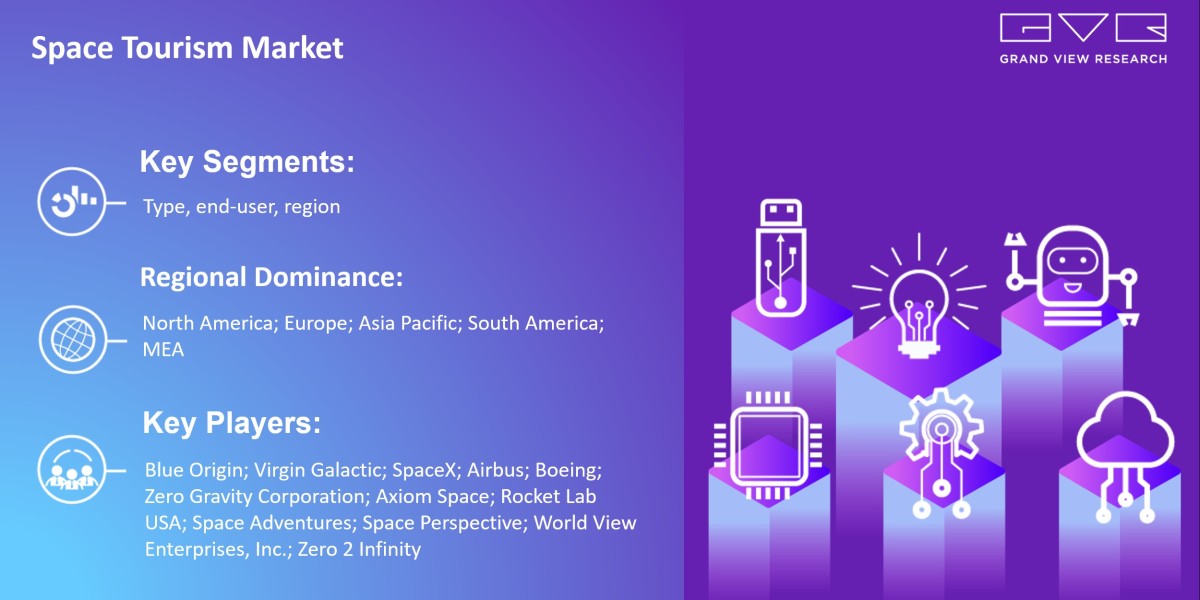San Francisco, 17 April 2024: The Report Space Tourism Market Size, Share & Trends Analysis Report By Type (Orbital, Sub-orbital), By End-use (Government, Commercial), By Region (North America, Europe, APAC, Latin America, MEA), And Segment Forecasts, 2024 - 2030
The global space tourism market size is expected to reach USD 9,669.5 million by 2030, according to a new report by Grand View Research, Inc. It is anticipated to expand at a CAGR of 44.8% from 2024 to 2030. Space tourism is defined as human space travel for recreational, leisure, or business purposes. A high-net-worth individual seeking a unique experience is willing to pay for space tourism, increasing demand for space tourism.
As space technology research, development, and commercialization accelerate, space tourism is becoming a solid commercial pillar of the space industry. Only a few governments and private players have recently entered the market, with the Russian government consistently expressing interest in developing space tourism capabilities. In January 2021, Glavkosmos, Roscosmos' commercial arm, announced that it would sell four seats on the Soyuz MS spacecraft, with launches scheduled for 2022 and 2023, respectively.
Space tourism is expected to allow more space research, making space science more accessible to individuals. Since space is costly at the moment, these flights will offer a much lower cost to do some research. Space tourism will also help in making new technologies. More space science implies new inventions, and most technologies are based on the transformation that started in space. Running shoes, bulletproof vests, foam mattresses, etc., are a few of the technologies we got from a space visit to the moon.
Space tourism can be divided into suborbital and orbital tourism. Suborbital tourism allows human spaceflight to the space border without sending the vehicle into orbit. In a suborbital flight, one never makes it into orbit. A flight duration in suborbital flight ranges from 2 - 3 hours. Orbital tourism enables travelers to experience orbit. Orbital flight implies staying in orbit, i.e., continually going around the planet at a very high speed to not fall back on Earth. These trips can long for several days or weeks.
Space tourism is harmful to the environment. In general, rocket launches are detrimental to the environment. Rocket engines, burning rocket fuels, release black carbon (soot particles) and harmful gases into the upper atmosphere, resulting in ozone depletion. However, a few space companies do not use black carbon for fuel. Companies like Blue Origin’s New Shepard uses liquid hydrogen-fueled gases in rockets. Hydrogen turns into water vapor when burning and does not emit carbon.
The reason why space tourism can be harmful to the environment is its potential popularity. As rocket launches are rising, carbon footprints will also increase. The company, Virgin Galactic is planning to launch 400 flights annually. The black carbon released by 1,000 space tourism flights results in a one-degree Celsius increase in the temperature of Antarctica.
A few companies working in space tourism are SpaceX, Airbus Group SE, Blue Origin, Boeing, ZERO-G, Virgin Galactic, and Axiom Space. In March 2022, Blue Origin launched its suborbital vehicle, New Shepard, on its first flight of the year, which carried six people on a short-term trip to space and back. The launch was deferred for nearly one hour by several countdown holds, including one that continued for more than 45 minutes. Later, Blue Origin said they required the time to work out a problem with the radio system on the vehicle that networks telemetry.
Request sample report of Space Tourism Market@ https://www.grandviewresearch.com/industry-analysis/space-tourism-market-report/request/rs1
Rising advancements in technology, growing inclination of adventure travelers, High Net Worth of Income (HNWI) individuals toward spaceflight, and increased focus on research and development activities by government and private research organizations are some of the factors fueling the growth of the market. Space tourism allows travelers to travel within and across the Earth’s orbit for leisure, recreation, or business purposes. Space tourism is anticipated to make travel accessible to lay and non-astronaut people in the coming years. The industry is expanding at a tremendous growth rate owing to technological innovations coupled with users’ inclination toward space adventures.
Space Tourism Market Report Highlights
- Space tourism is adopted by wealthy families, affluent individuals, or anyone with enough money who wants a different experience and is eager to pay for space tourism
- Space tourism has increased overall space exploration activities. In November 2020, SpaceX launched non-astronauts to the International Space Station (ISS), which marked a new era of space exploration
- The suborbital segment is expected to dominate the market and expand at a CAGR of 44.3% from 2024 to 2030
- The commercial market for space tourism is projected to grow at the highest CAGR during the forecast period
- The primary source markets for space tourism are the U.S., Japan, China, India, the U.K., Canada, Germany, Hong Kong, France, and Australia
- The U.S. will be the primary source market for space tourism companies. When promoting their expeditions and hotels, all players in the space tourism sector focus on the U.S. market, as campaigns aimed at this market are likely to have the most significant impact
In 2021, there were 146 space launches, out of which 51 were from the U.S., 55 from China, and 25 from Russia. The launches are expected to rise, which can deteriorate the ozone layer, thus creating a detrimental effect on the Earth’s climate. In June 2022, researchers from the Massachusetts Institute of Technology (MIT), the University of Cambridge, and the University College London (UCL) observed that the soot emitted from rocket launches had impacted the atmosphere by generating more heat when compared to other emitting sources.
The emitted pollutants are responsible for the depletion of the ozone layer in the stratosphere. The spacecraft sent into orbit follows a multi-stage configuration and is plunged to pass through the Earth’s atmosphere. With every stage, the auxiliary parts are separated from the launch vehicle and are discarded or reused in further explorations.
The industry has remarkably evolved in the U.S. and Europe owing to the accessibility of launch facilities, commercial space launches, technological breakthroughs, and space tourism. The market is consolidated, with a few players dominating and capturing a significant share. These players have been planning on research and development to build orbital and suborbital vehicles to travel to space in the coming years. These companies have invested an enormous sum of the amount, as the industry is anticipated witness exponential growth.
The space tourism industry has a very high level of innovation since businesses are always trying to come up with new ideas and cutting-edge technologies to improve the entire space travel experience. This innovation includes improvements in propulsion systems, safety procedures, and consumer engagement tactics in addition to spaceship architecture. The sector is ready to launch ground-breaking solutions that push the frontiers of space tourism, drawing a wide spectrum of clients and encouraging long-term growth, thanks to continuous investments in research and development.
Space Tourism Market Report Scope
Report Attribute | Details |
Market size value in 2024 | USD 1,048.6 million |
Revenue forecast in 2030 | USD 9,669.5 million |
Growth Rate | CAGR of 44.8% from 2024 to 2030 |
Actual Data | 2017 - 2023 |
Forecast period | 2024 - 2030 |
Given the unique nature of space flight experiences, there aren't many alternatives to services in the space tourism business. Space tourism is a niche product with few direct competitors, despite the possibility of substitutes in the form of typical travel and leisure activities due to its inherent appeal and distinctiveness. With the business growing and becoming more accessible, there is a chance that demand will rise without much competition from other services, making space tourism a unique and sought-after experience for travelers looking for adventures that cannot be found anywhere else on Earth.
List of Key Players in Space Tourism Market
- Blue Origin
- Virgin Galactic
- SpaceX
- Airbus
- Boeing
- Zero Gravity Corporation
- Axiom Space
- Rocket Lab USA
- Space Adventures
- Space Perspective
- World View Enterprises, Inc.
- Zero 2 Infinity








